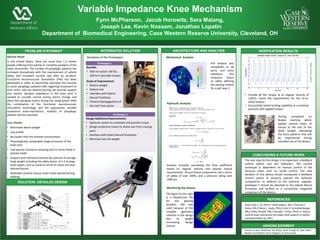
380 poster
- 1. PROBLEM STATEMENT Variable Impedance Knee Mechanism Fynn McPherson, Jacob Horowitz, Sara Malang, Joseph Lee, Kevin Nossem, Jonathan Lopatin Department of Biomedical Engineering, Case Western Reserve University, Cleveland, OH INTEGRATED SOLUTION ARCHITECTURE AND ANALYSIS VERIFICATION RESULTS CONCUSIONS & FUTURE WORK REFERENCES AKNOWLEDGMENT Market Need: In the United States, there are more than 1.5 million people suffering from partial or complete paralysis of the lower extremities. The number of paraplegic patients has increased dramatically with the improvement of vehicle safety and increased survival rate after an accident. Functional neuromuscular stimulation (FNS) has been developed in order to electrically stimulate the muscles to assist paraplegic patients with regaining movement of their limbs, and exo-skeletal bracing can provide support and control. Variable impedance in the knee joint is needed to provide control during stance change and allow free-swinging motion during the swing phase. With the combination of the functional neuromuscular stimulation technology and the appropriate variable impedance knee-mechanism, mobility of paraplegic patients will be improved. User Needs: • Minimized device weight • Low profile • No louder than the ambient environment • Physiologically comparable range-of-motion of the knee joint • Low passive resistance allowing joint to move freely in passive mode • Support joint moments exerted by a person of average body weight including the safety factor of 1.5 at large knee angles, such as stand-to-sit/sit-to-stand and stair descent/ascent. • Modulate resistive torque under loads exerted during walking. Iterations of the Prototypes Department of Veterans Affairs Prototype 1 Benefits • Able to sustain 100 lbs, 200 N-m (provide torque) Areas of Improvement • Reduce weight • Reduce size • Interface with Hybrid Neural Prosthesis • Prevent disengagement of the rack from pinion Prototype 2 Design Additions/Improvements • Hydraulic system to modulate and provide torque • Design protective covers to shield user from moving parts • Interface with Hybrid Neural Prosthesis • Minimize size and weight The next step for this design is to implement a feedback control system into the hydraulics. The current prototype is dependent on manual control of the pressure valve, with no active control. The next iteration of this device should incorporate a feedback control system to properly operate the hydraulic components. In addition to the hydraulic upgrade, prototype 2 should be attached to the Hybrid Neural Prosthesis and verified as a successfully integrated component of the device. 0 5 10 15 20 25 30 -10 0 10 20 30 40 50 60 70 Torque(Nm) Variable Stand-to-Sit: Torque vs. Time, 60 Nm time (s) 0 5 10 15 20 25 30 -200 0 200 AngularVelocity(deg/s) Testing completed on Biodex machine which applies precise levels of torque to the end of the distal upright, simulating the force patterns that will be experienced during intended use of the device. • Provide 60 Nm torque at an angular velocity of 120º/s, meets the requirements for the sit-to- stand motion. • Successfully tested locking capability at a constant pressure with applied torque FEA analysis was completed on all parts, and some interfaces. The minimum factor of safety defining the passing criteria for a part was 2. Mechanical Analysis: Hydraulic Analysis: Analysis included calculating the flow coefficient based on angular velocity and passive torque requirements. All purchased components had a factor of safety of over 200%, and a pressure rating over 1000 psi. Machining the Device: The figure to the right is a MasterCam file for the bearing brackets. CNC was used because of the complex geometry inherent in the design due to weight minimizing design choices. SOLUTION: DETAILED DESIGN Thanks to Jason Bradshaw, Jim Drake, Sarah Chang, Dr. Tyler, Mark Nandor, Rudi Kobetic, Kevin Foglyano, Dr. Musa Audu Ibid Curtis S. To, PhD;1* Rudi Kobetic, MS;1 Thomas C. Bulea, MS;2 Musa L. Audu, PhD;2 John R. Schnellenberger, MS;1 Gilles Pinault, MD;1 Ronald J. Triolo, PhD1–3. Stance control knee mechanism for lower-limb support in hybrid neuroprosthesis (p. 841).